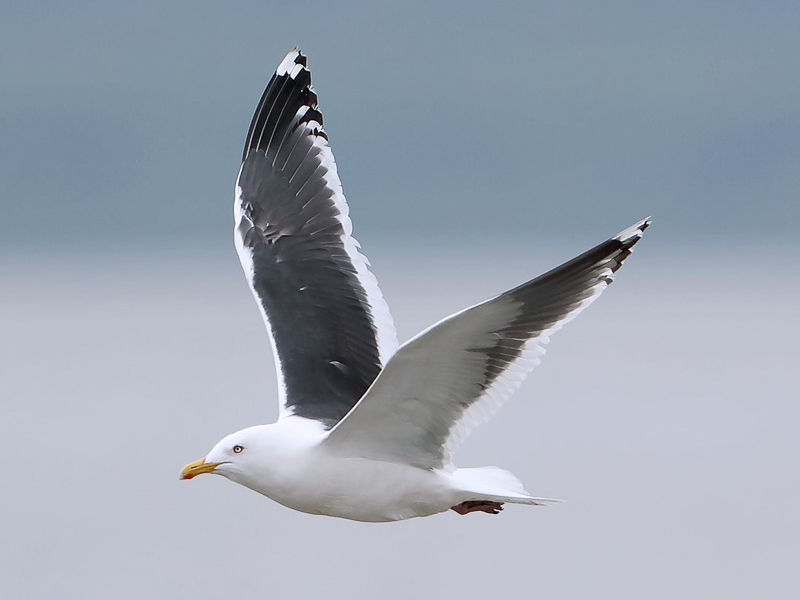Slaty-backed Gull Larus schistisagus 灰背鷗
Category I. Scarce winter visitor and passage migrant in early spring to Deep Bay and coastal waters.
IDENTIFICATION

Mar. 2014, Michelle and Peter Wong.
55-67 cm. Large, often stocky with relatively short wings, stout bill and deep pink legs.
First-year birds usually occur, which in fresh plumage are generally brown overall with blackish wings, rather plain greater coverts, darker face and dark bill. However, plumage is prone to fading, especially in the strong sunlight of more southerly latitudes. Such birds often acquire a very pale head, neck and chest (accentuating the all-dark bill and dark belly), pale fringes around the tips of the primaries and bleached wing coverts. Those that retain most juvenile plumage are especially bleached. First-winter birds vary in appearance more than other gulls in HK. Second-year birds acquire slate grey in mantle feathers, often with broad whitish tips, and some have a pale iris.

Mar. 2012, Geoff Carey.
In HK first-year birds in flight typically show all-dark tail (sometimes slightly paler at base of outer tail feathers), slightly paler wing panel on inner primaries, pale greater coverts and dark secondaries.

Mar. 2017, Michelle and Peter Wong.
Adults are rare in HK. They have slate-grey upperparts, broad white tertial crescent, pale iris and in non-breeding plumage greyish-brown streaks on head and neck and sometimes a very pale, dull bill.

Mar. 2017, Michelle and Peter Wong.
In flight the adult shows a broad white trailing edge to the secondaries and inner primaries, dark flight feathers on the underwing and a rather small mirror on the outermost primary and sometimes the penultimate.
VOCALISATIONS
Calls are rarely heard in HK. Vocalisations are similar to other large gulls.
DISTRIBUTION & HABITAT PREFERENCE
Most records are from the late winter and early spring gull roost that forms on the falling tide in Inner Deep Bay near the Mai Po Boardwalk hides. Occasionally also recorded in migratory flight over southern waters and off northern Lantau in February and March.
OCCURRENCE
Figure 1 indicates that Slaty-backed Gull is a winter visitor and early spring passage migrant mainly from the second week of January to early April, with numbers peaking in March. While it is possible that fewer diurnal high tides in December mean numbers present in early winter are understated, it is perhaps more likely that most birds either occur in response to cold weather further north or are on northward migration.
Extreme dates are 7 November 2016 (not followed until 26 November) and 19 April 2014. Most birds recorded are in their first-year, with a few second-years and adults rarely.
The first record for Hong Kong was of two first-winter birds at the former Pak Nai beach gull roost on 17 March 1984.
BEHAVIOUR, FORAGING & DIET
No behaviour noted that is different to other large gulls.
RANGE & SYSTEMATICS
Monotypic. Breeds in around the coast of the Sea of Okhotsk and the east Bering Sea in northeast Siberia, south as far as Hokkaido; winters in the breeding areas and south through Japan and Yellow Sea coasts, regularly as far as south China (Burger et al. 2020), where numbers are low based on HK records.
CONSERVATION STATUS
IUCN: Least Concern. Population trend unknown.
Figure 1.

Burger, J., M. Gochfeld, E. F. J. Garcia, and G. M. Kirwan (2020). Slaty-backed Gull (Larus schistisagus), version 1.0. In Birds of the World (J. del Hoyo, A. Elliott, J. Sargatal, D. A. Christie, and E. de Juana, Editors). Cornell Lab of Ornithology, Ithaca, NY, USA. https://doi.org/10.2173/bow.slbgul.01

